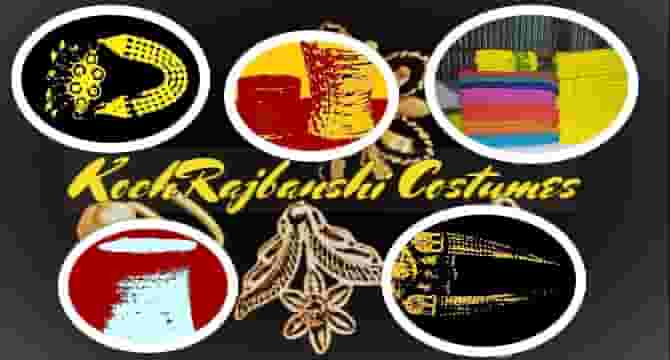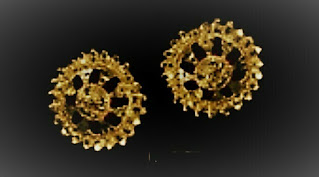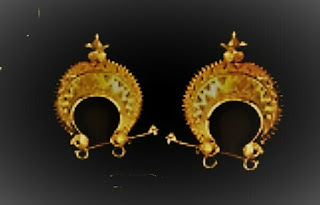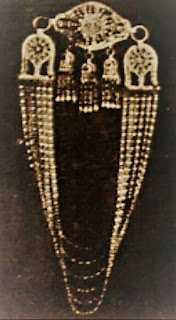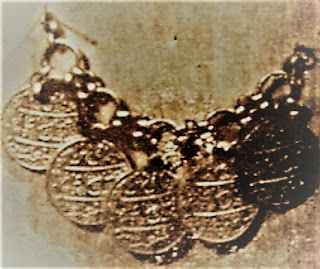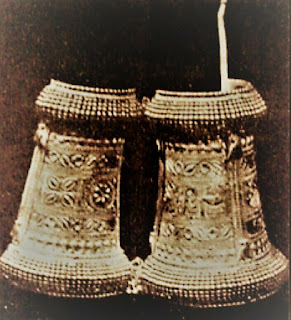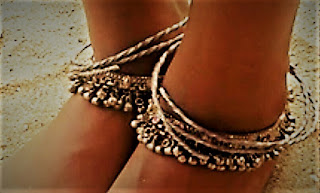What are Koch Rajbanshi traditional dresses and Ornaments?
Patani or Phota is the customary dress of Kamtapuri Koch Rajbanshi / Rajbongshi lady. It is made at home in various colors and designs. There are fifteen kinds of patani, for example, are Dhalakala, Bulukdhala, Maldoi, Saishyaphuli, Ghuni, Dhala, Toroiphuli, Chikonpair, Doraduri, Saada, Ghugupari, Guthaotha, Chotapari, Suryapuri, and Chotari. This type of dress is antique or old fashioned and it is noted that the reference of Patani is likewise accessible in the antiquated book “Manashakabya” by Mankar in the tale of Behula and Lakshindar. We found another line which was “Hajar takar kuchuni tao pende patani” – Dr. C.C. Sanyal (The Rajbanshi’s of Northbengal).
Now a days we generally don’t see women dressed with patani at common places at North Bengal but some occasional purpose this patani fashion is being regained.
Phota or patani is a shaded material of Five cubits in length and 2.5 cubits wide. Ladies tie simply over the bosom and it hang down up to the knees. The two closures of the Phota are not sewn together. It is an open material. “Angcha is the customary dress of Koch-Rajbanshi men. It is made in handloom at home in various shadings with 6 feet of length and 3 feet wide. Gamcha is a rectangular piece of cotton fabric created in handloom extraordinarily yellow in shading. It has an extraordinary importance among the Koch Rajbanshis which is customarily viewed as an issue of training and nobility and utilized as a towel. Pachara is a kind of wrap utilized by both man and lady society of Koch Rajbanshis setting it up in handloom uncommonly with cotton or Eri silk yarn. Some other customary clothing types of Koch Rajbanshis are- Kheta, Parna, Kabwos kapur, Dagila, Andee pachara Urna, Jol gamcha etc.
Jewellery or ornaments of Koch Rajbanshi
Koch Rajbanshi men generally dont wear ornaments. Very few wears silver ring in their fore finger or little finger. But koch rajbanshi ladies put in various types of ornaments. Most of them are designed with silver. Those silver ornaments were generally thick and heavy. Ornaments or jewellery were bank vault of women. As per traditional or age-old practices jewelery used to purchase against extra savings.
The Koch Rajbanshi ladies of Assam, West Bengal, Bihar, Nepal and Meghalaya do wear some unprecedented jewelleries of various designs in various pieces of the body, for example, ear, nose, neck, wrist, abdomen, arm, lower leg, finger, toe and so forth alongside their conventional clothing types to improve the character and engaging quality. These ornaments are essentially made of gold, silver, copper, Brass, shell and so forth.
Koch Rajbanshis, who were economically stronger they wear golden ornaments. Common people generally used to put on silver ornaments.
So many varieties of ornaments were used by koch rajbanshi ladies. Some ornaments are kept inside almirah or sonduk for occasional use. Married ladies use vermilion on their forehead but widow dont use vermilion. Koch Rajbanshi dont use tattoos. But for sake from bad deity use maduli and koboch on neck and wrist. Below mentioned ornaments were used about 60-70 years ago. Now a days most of them are out of market because of unavailability, influence of other culture and their own undesireness.
KochRajbanshi ornaments for head
Shitha Pati (শিথা পাটি) – A silver chain fixed on the hair along the middle line where the hair is parted just above the fore head. A pendant sometimes fixed with this chain
Shed-bon (শেড বন) – A helmet made with silver.
Koch Rajbanshi ornaments for ear
Makri (মাকরি) – Earing of gold or silver, ornamented, worn on the lower part of the ear.
Chaki (চাকি) – Double earings worn in the upper part of the ear, covering the whole of the ear.
Onti, Enti (ওন্তি, এন্তি) – Plain and round earing worn on lower part of the ear.
Shona, Sisa (সোনা, শিসা) – Gold or Silver earing with a chain passing round the ear. It is little bigger than ‘Onti’.
Guzi (গুজি) – Small gold or silver flower with a stalk fixed through a hole in the lobe of the ear
Machia pat (মাছিয়া পাত) – Earing with pendant (silver or gold) worn on upper part of ear.
It should be noted that one should use either ‘onti’ or ‘Shona’ ‘Sisa’ or ‘Makiri’ at the same time. One should use ‘Sitha pati’ on head and ‘chaki’ on the ear at the sametime as the chain of ‘Sitha-pati’ will be fixed to the ‘chaki’ to keep it in place.
Fulkuri
Makri
Ear Ornaments
Ornaments for nose
Nose Ornaments are worn in the front soft part of the nostril or of the nasal septum which had been pierced when the woman was quite young.
Nolok (নোলোক) – A bead suspended from the lower nasal septum.
Phul (ফুল) – Gold or silver nose flower.
Noth (নথ) – A gold or silver ring worn through the hole in the lower nasal septum.
There are two types of ‘Noth’ –
a. Solia (সোলিয়া)
b. Joltupa (জলটুপা) – It is chained to the ear.
Bali (বালি) – same as ‘Noth’.
Phur-kuri (ফুর কুড়ি) – Nose flower or ring with pendant.
Nakful
Nose Ornaments
Ornaments for neck
Surjyo har (সূর্য্য হার) – A heavy necklace. The weight is about 60 tolas (1 tola=11.66gm). Now a days it is out of market but during 60-70 years ago the price of this Surjyo har was Rs. 700/.
Chandra har (চন্দ্র হার) – A necklace weighing about 4o tolas. Both sujjo-har and Chandra-har were worn by rich Koch Rajbanshi families. During 1950-60s the cost of Chandrahar was Rs. 400/.
Shikli har (সিকলি হার) – Necklace with silver beads.
Chora kathi or Kathi mala (চোরা কাঠি বা কাঠি মালা) – The beads of the necklace are large and round, sometimes rectangular, chained at angles.
Taka chara (টাকা চারা) – A necklace with Silver rupees.
Sikka har (সিক্কা হার) – A necklace with Sikka rupees.
Modhu mala (মধু মালা) – A necklace with square beads.
Chandra har
Chandra har (large neck piece)
Chora kathi
Surjyo har
Surjyo har (another view)
Hashuli
Sikka har
Neck Ornaments
Boal kathi (বোয়াল কাঠি) – A nacklace with rectangular beads.
Kuchia mara har (কুচিয়া মারা হার) – A necklace with three layers of silver beads.
Hasula, Hasuli (হাশুয়া, হাশুলি) – A short and thick silver necklace.
Poal mala (পোল মালা) – A red coral necklace.
Kathi kala mala (কাঠি কলা মালা) – Necklace of glass beads.
Got (গোট) – A necklace made of silver rings.
Ornament for finger
Angti (আংটি) – A silver ring.
Ornaments for wrist
Gokul kharu / Gota kharu / Mota kharu / Muthia kharu (গোকুল খারু / গোটা খারু / মোটা খারু / মুঠিয়া খারু) – Ornamented silver wristlet worn round the right wrist. Worn by woman with hushand alive. A widow may wear Mota Kharu on the left wrist and Gota Kharu on the right
Mutha-Kharu, Baoti (মুঠা খারু, বাউটি) – A wristlet 0.75-1″ wide.
Chur or Churati (চুর বা চুরাতি) – Silver bracelet.
Roton chur (রতন চুর) – Worn on the back of the palm with chains attached to finger. It nearly covers the dorsum. Used by rich people at the time of marriage ceremony.
Shakha kharu
Mutha kharu (open view)
Mutha kharu
Gota kharu
Wrist Ornaments
Ornaments for hand
Mota kharu (মোটা খারু) – Wide ornamented silver bangle covering almost half of the hand.
Sakha kharu (শাখা খারু) – It is Conch-shell bangles, Worn on the left hand. Twelve bangles are placed one above the other and pasted with gum, covering nearly half of the forearm. It is worn by woman whose husband is living. It is broken off after he is dead and never worn even if she is married again.
Bahu-Kharu, Godzra, Sompandzi ( বাহু খারু, গজরা, সোমপান্জি) – Ornamented silver bangles 2”-4” wide.
Konkon (কঙ্কন) – It is like mota kharu with pendant. It is very heavy, about 20 tolas in weight.
Ornaments for arm
Kata bazu (কাটা বাজু) – A silver band, 0.25-0.5” wide generally with two and half turns,
Tar bazu (তার বাজু) – A twin ornamented armlet 0.5” wide.
Bas patari (বাঁশ পাতারি) – A thick band 1” wide armlet of silver.
Koch Rajbanshi ornaments for waist
It is said that ‘Bayar Chanir Komorat Sikoi’ – Low class woman has ornament round the waist. It is chain ornament or sikoi ornament. Sometimes Silver ornament round the waist is used at the time of marriage when Sari is worn. It weighs about 4o tolas. It is called ‘Got’
Koch Rajbanshi ornaments for leg
Theng kharu (ঠ্যাং খারু), Bak kharu/
– Silver anklet.
Par kharu (পা-র খারু) – Thick and heavy anklet.
Chor kharu (চর খারু) – Plain or twisted silver circles. Two to three on each ankle,
Mal (মল) – Silver rings with six facets ending in knobs.
Theng kharu – palish pata
Chor kharu – palish pata
Theng kharu
Par kharu
Leg Ornaments or Jewelry
Ornaments for foot
Paizo, Pazor and Panza (পাইজো, পাজোর, পান্জা) – Silver lettice work ornament covering the dorsum of the foot and tied with chains to the fingers.
Angti (আংটি) – Silver ring worn round the great the with a ball or bunch of small balls resting on the enterior aspect of the great finger.


